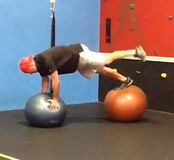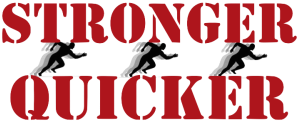 In my last post Core Training Part 1, I covered core stability, the foundation of your core. Today is going to focus on core strength... Yes what you look at in the mirror. These muscles help with your core stability of course, but the main function is to twist, bend, extend (or any combination of those motions) your trunk. This means you can't be an athlete without them. To keep things simple here is a crash course:
Core Strength is needed for weightlifting, all quick/powerful movements and body control, which are demanded of the game of football. The core is relied upon through the scope of strength exercises like squat, bench press, deadlift and overhead press. These movements require the spine to hold a firm position so the hip and shoulder joints can move with force. But also core strength is also used to twist and tackle, throw a 30yd pass and to kick that game winning 40yd field goal. Core Stability + Neurological Efficiency = Body Control Core Stability + Core Strength + Body control = Foundation for Power Production Core Strength Exercises include (but not limited to) the following: V-ups, Cable crunch, Med ball chops, Russian twists & back extensions (with or without rotation). Want to test your Core Strength? Under 16: perform 20 v-ups without letting your feet touch the ground. 16+ perform 20 v-ups with 10% of your body weight split into two dumbbells you keep in your hands. Note: make a 'V' not a 'U' so you must be sitting on your butt at the top position. Next Week Pt. 3 I'll get into Core Power Don't waist your talent, release your inner athlete by getting StrongerQuicker! Click HERE to view my training products. Written By: Coach Ryan Bishel, BA, PES Like this article? Thank me by sharing it or give it a "LIKE!"
0 Comments
 (YES) I Walk the Talk! (YES) I Walk the Talk! It's amazing that most athletes aren't taught this Basic, Easy & Amazingly helpful information that is vital to athletic success... But, at least you are reading this now ... and I tip my hat to you. (Yes I'm a country boy at heart) What is the only bone structure that connects your upper and lower body? That's right, your spine! Don't you think it would be a bright idea to protect it? (...Unless you would like a very short career, then your answer should be yes!) So let's learn about what protects and stabilizes it, your Core muscles. To keep things simple here is a crash course:
Core Stability is the foundation for quick/powerful movements and body control, which are demanded of the game of football. It is the ability to support & connect the forces from your arms and legs during all movements on the field. Got Power? Well power relies on the efficiency of your muscular effort and body control. You can have tree trunks for legs, but if your core is weak and lacks stability then you are no where near your potential and have a greater risk of injury. Core Stability allows you to Cut, Accelerate, Hit (and take a hit for that matter), Tackle & Block ...So stability training MUST be in your weekly training program no matter what position you play out there. To Amazingly Easily Understand: Core Stability + Neurological Efficiency = Body Control Body Control = Prevent Injury, Cut Quickly, Explode, Juke, Hit, Tackle, Accelerate ... Get it? Highlight reel stuff :) Core Stability Exercises include (but not limited to) the following: Planks, bridges, side bridges, glute-march bridges and stability ball stabilization exercises. Want to test your Core Stability? Time how long you can hold a plank on your elbows and toes... By my athletic standards as a Performance Coach, the minimum time should be 3min. (and yes, without arching your back and looking like a half-pipe for a skateboarder to use) Next Week Pt. 2 I'll get into Core Strength Don't waist your talent, release your inner athlete by getting StrongerQuicker! Click HERE to view my training products. Written By: Ryan Bishel, BA, PES Like this article? Thank me by sharing it or give it a "LIKE!" |
Details
AuthorRyan Bishel, BA, PES has been coaching athletes since 1999. Numerous athletes have competed in NCAA athletics and professional sports. Archives
October 2014
Categories |

 RSS Feed
RSS Feed
